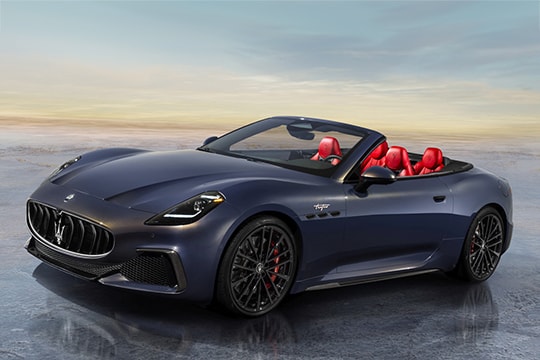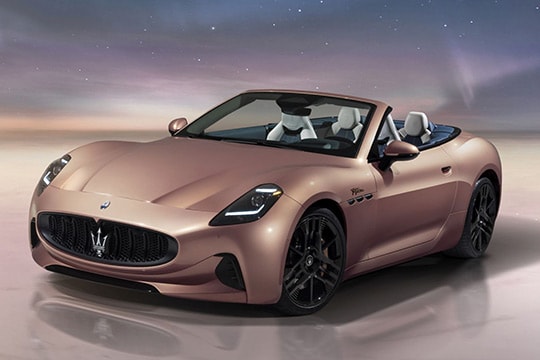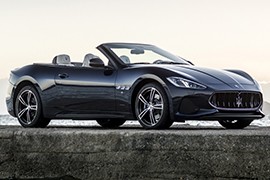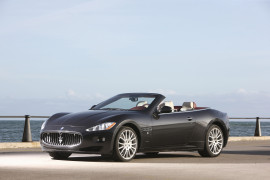MASERATI GranCabrio Models/Series Timeline, Specifications & Photos
First production year: 2010
Engines: Gasoline, Electric
Body style: Convertible (spider/spyder, cabrio/cabriolet, drop/open/soft top)
It was only a matter of time before Maserati would chop the roof of the GranTurismo Trofeo and create the open-top version of it, namely the GranCabrio Trofeo, which it unveiled in 2024.
After successfully producing the first generation of the GranTurismo for twelve years, between 2007 and 2019, the Italian automaker allowed itself a three-year break in the segment. As a result, in October 2022, Maserati launched the second generation of this moniker in an online event and then waited for more than a year before launching the open-top version of it, the GranCabrio. While this pause kept its fans on their toes, the result was highly desirable, especially in the Trofeo variant that provided a powerful engine and a driver-oriented chassis. Even though it wasn’t the kind of vehicle someone would use for track days, it was still very fast. But it was not a supercar.
In its Trofeo clothing, the GranCabrio featured an aggressive front fascia that sported eight vertical slats and the big and silver Tridento badge in the middle. Above the bumper, Maserati installed a pair of extracting vents on the lower side of the hood, while on the sides, it placed the LED headlights with integrated daytime running lights. Lower, on the apron, the automaker installed a pair of intakes adorned by carbon fiber trims and a splitter on the lower side.
From its profile, the car retained the same shape as its coupe sibling, sporting three vents on the front fenders and the Trofeo badge above them. The raked windshield had thick A-pillars that served as rollover protection. These were followed by an ascending waistline that continued all the way to the rear wheels, only to descend slowly towards the back of the convertible. Finally, the rear fascia featured horizontal LED taillights that emerged from the quarter panels to the trunk’s lid. To emphasize the car’s sporty character, Maserati installed a carbon fiber diffuser that integrated the quad exhausts.
The cabin offered a blend of luxurious items, leather upholstery, and high-bolstered front seats. Fronting the driver was a flat-bottom steering wheel, and behind it, there was an LCD for the instrument panel. Between the front occupants, the automaker installed a tall center console that housed an armrest with a storage area underneath it and a pair of cup holders. At the same time, the center stack was filled by two touchscreens where. The one placed above was for the infotainment system, while the one below it was for the HVAC. In the back, Maserati installed a bench seat profiled for two people, but despite the vehicle’s long wheelbase, there was not enough legroom for grownups. The automaker pushed the rear seats forward to make room for the retractable rag-top behind them. At the touch of a button, the driver could cover or uncover the vehicle while driving at speeds of up to 50 kph (31 mph).
Under the hood was the mighty Nettuno (Neptune) engine carried over from the GranTurismo Trofeo. The three-liter V6 powerplant was helped by a pair of turbochargers to produce 542 PS (535 hp), which it sent to the rear wheels via an eight-speed automatic transmission.
After it stunned the world with the debut of the all-electric GranTurismo Folgore (Lightning) in January 2023, the Italian automaker unveiled the open-top version of it, the GranCabrio Folgore in the spring of 2024.
Usually, automakers didn’t need that much time to create an open-top version of a coupe vehicle, but Maserati didn’t want to push too hard when it created its first full-electric open-top vehicle. It was a daring challenge, but the automaker did it. By using the same drivetrain and platform as the second generation of the GranTurismo model, it could have shaved some time, but it didn’t. It tried to approach things thoroughly and tested the GranCabrio to its limits to create not just one of the fastest electric convertibles on the market but also an elegant one that could take its occupants on long travels. To create it, it had to reinforce the bodywork, secure the battery area, improve the cabin, and make it suitable for four persons. After a few generations of open-top, four-seat grand tourers, it didn’t want to deceive its customers, who expected a similar experience with the 2025 GranCabrio Folgore.
While the first generation of the Maserati GranTurismo was penned in Pininfarina’s Design Studio, the second generation of this nameplate was created in the carmaker’s styling center. It kept similar proportions to its predecessor and sported a front fascia that resembled it. Unlike that, though, it didn’t need that much cooling area. As a result, the panel that covered the grille almost entirely sported a honeycomb pattern and was interrupted by eight vertical gaps. On the lower bumper, a pair of side scoops flanked the broad grille, and underneath it was a tiny lip spoiler. Like its fixed-roof sibling, the GranTurismo Folgore, the GranCabrio featured a pair of vents on the hood, which helped to cool the radiators and, subsequently, the batteries.
From its profile, the GranCabrio featured the same three vents on the front fenders as its coupe sibling, representing the number of electric motors that powered the vehicle. Maserati focused on aerodynamics, so it sculptured the door panels on the lower side, above the side sills. The car could be opened and closed at the switch of a button in 14 or 16 seconds, respectively, at speeds of up to 50 kph (31 mph). It retracted behind the cabin in a designated area between the trunk and the rear seats. In the back, the automaker mounted horizontally LED taillights, which stretched onto the trunk’s lid from the quarter panels. As expected, there was no exhaust at the back of the vehicle since it was electric. There, Maserati placed a diffuser on the lower side of the bumper.
The cabin was the one that was greatly enhanced over the coupe version of the car. Besides the regular features, which included a touchscreen for the infotainment system and a TFT display fronting the driver as an instrument cluster, the automaker added new functions to the car. As standard, the GranCabrio Folgere featured a neck warmer, which blew behind the front occupants’ necks to make them feel good even when the roof was down, and the weather was not too hot. In addition, the automaker added a wind-stopper that could be placed above the rear seats and protected the front occupants from turbulences.
Under its skin, the GranCabrio Folgore had the same tri-motor setup as the GranTurismo Folgore. Combined, these provided the all-wheel drive convertible a total output of 560 kW (762 hp) that could rocket the car from naught to 100 kph (0-62 mph) in 2.8 seconds, onto its way to a top speed of 290 kph (180 mph).
Maserati restyled the GranTurismo and the GranCabrio vehicles for the 2018 model year, bringing a well-deserved update to both cars.
The Italian automaker had to update the engine for the GranCabrio when the Euro6 emission standards came into force in Europe, but it did that quietly, without any other updates for the rest of the car. One of the most challenging parts to enhance was the Pininfarina-designed bodywork. Maserati’s styling team had to add new lines without ruining the work of art created by Jason Castriota from the famous Italian design institute. The automaker offered both siblings, the GranTurismo and the GranCabrio, in no less than 16 exterior colors and a staggering choice of 14 alloy wheels in six designs. In addition, the automaker updated the technological package for the interior.
At the front, the redesigned headlights had the same profile, but their interior parts were enhanced and restyled. The carmaker’s design team even added the Maserati name written above the Bi-Xenon lamps. Another significant change was noticed in the main grille, which kept its octagonal shape but with more angular lines instead of the shaved corners as on the non-facelifted version of the GranCabrio. At the same time, the lower bumper boasted new, larger side scoops.
The GranCabrio’s curved lines were mainly left untouched by the Maserati Design Center, albeit there were some subtle modifications in a few details. On the front fenders, the three vents were kept but sported a chromed finish. Another change was noticed on the side sills, which were redesigned for improved aerodynamics. The GranCabrio had one of the best drag coefficients on the market, boasting a Cx of 0.35 with the roof up, which increased a little to 0.39 with the top down. At the back, the automaker redesigned the diffuser under the bumper and exchanged the four quad exhausts with a pair of oval-shaped ones, neatly peaking out through designated scoops.
One of the areas that was dramatically improved was the interior. Maserati dared more and offered a few trim levels for the cabin, including a sports-oriented one fitted with high-bolstered bucket seats at the front. That version also featured carbon fiber trims on the dashboard, center console, and door cars. One significant upgrade was noticed on the center stack, where the car manufacturer included a fresh 8.4-inch touchscreen for the infotainment system that supported Apple CarPlay and Android Auto connectivity. The HVAC controls were integrated into it, so there were fewer buttons to clutter the center console. All versions delighted their occupants with a Harman Kardon sound system that was fitted as standard. The automaker offered the GranCabrio in a choice of eight interior colors and five trim options.
Under the hood, the automaker installed an updated version of the Ferrari F136 engine, which was hand-built in Maranello. The new powerplant delivered 20 more ponies than the 2010 GranCabrio, reaching a total of 460 PS (454 hp) from its 4.7-liter displacement. It was paired with a standard six-speed automatic gearbox enhanced for smoother gear changes.
Maserati introduced the GranCabrio at the 2009 Frankfurt Motor Show, with production starting in the following year, based on the same platform as its coupe sibling, the GranTurismo.
In 2010, the world financial crisis was still ongoing, and automakers had a difficult time finding customers for their products. But Maserati knew that deep-pocket buyers still had enough to purchase exclusive, beautiful cabriolets. In addition, the Italian automaker didn’t try to sell tens of thousands of the GranCabrio, just a couple of thousands per year. That target was not impossible, so their only problem was to find the right design and engineering solutions to make the car as desirable as possible. With this model, it hit the spot since it was a true four-seat convertible. One in which the rear seats were not just for small-sized dogs and purses. In addition, the open-top version of the GranTurismo was powered by the same Ferrari-developed engine, which provided enough power and a pleasant sound. Deliveries started in early January 2010, and the car manufacturer proved to anyone that it was right. The sales exceeded 11,000 units until the model’s replacement in 2022.
The Italian car manufacturer had a long history of making breathtaking-looking convertibles, and for the 2010 GranCabrio, it employed Pininfarina to design it. At the front, the car sported a broad grille with rounded edges adorned by vertical slats where the Tridento badge took center stage. It shared the headlights with its coupe sibling, featuring a swept-back look. Underneath them, the automaker placed round fog lamps, while below the bumper, it placed a lip spoiler.
From its profile, the GranCabrio revealed its long hood and curved fenders, where Maserati placed a set of three vents and the Pininfarina badges. The car’s slanted windshield was supported by thick A-pillars, which served as safety arches as well. With a curved waistline that ascended towards the rear deck, the convertible had an elegant and dynamic line. The power retractable canvas roof could be lowered and closed in about 28 seconds at speeds of up to 32 kph (20 mph). At the back, Maserati installed a pair of broad, triangular taillights that emerged from the quarter panels onto the trunk’s lid. At the same time, below the bumper, the automaker added a large diffuser flanked by four oval exhausts.
The leather-wrapped interior of the GranCabrio greeted its customers with comfortable bucket seats at the front separated by a tall center console. Fronting the driver was an analog instrument panel filled with two large dials for the speedometer and tachometer that flanked a TFT display and the smaller-sized fuel level and the coolant temperature gauges. On the center stack, the automaker installed the infotainment system that featured navigation, a CD player and supported Bluetooth connectivity for calls and media. In the back, legroom was more than enough for most customers.
Under the hood stood a handbuilt 4.7-liter engine provided by Ferrari, Maserati’s owner group. The automaker provided the GranCabrio with either a six-speed automatic that sent the torque to the rear wheels only.



